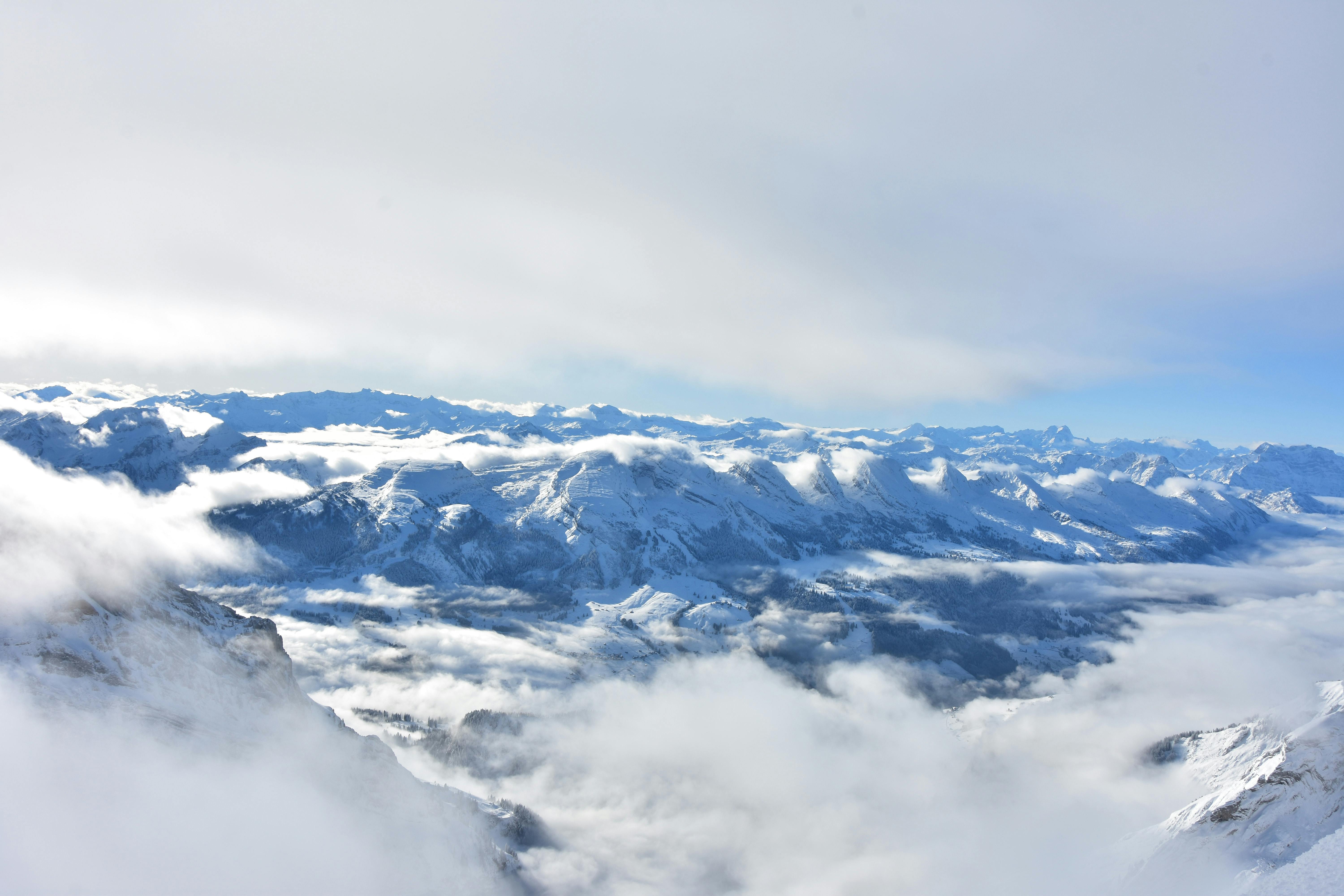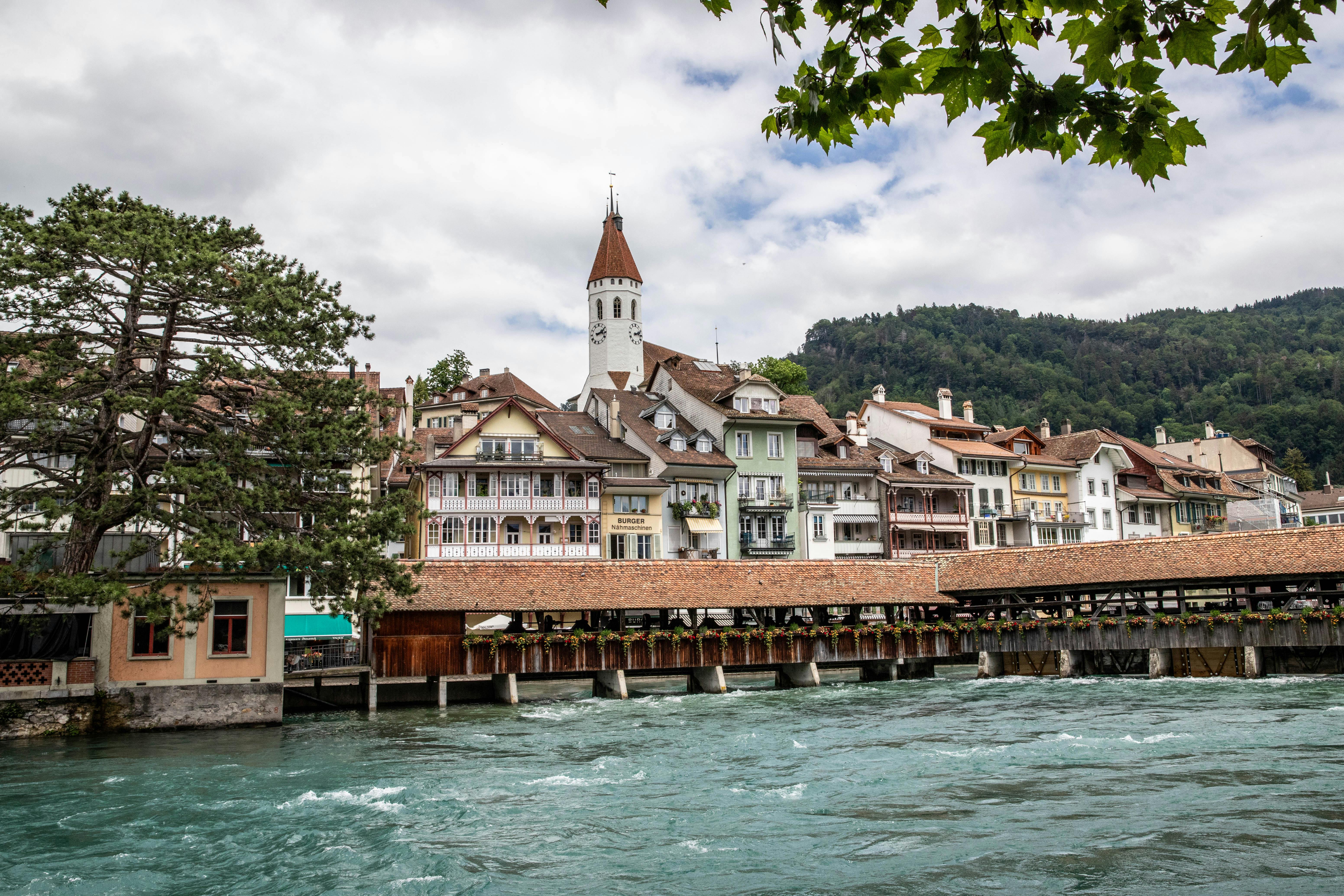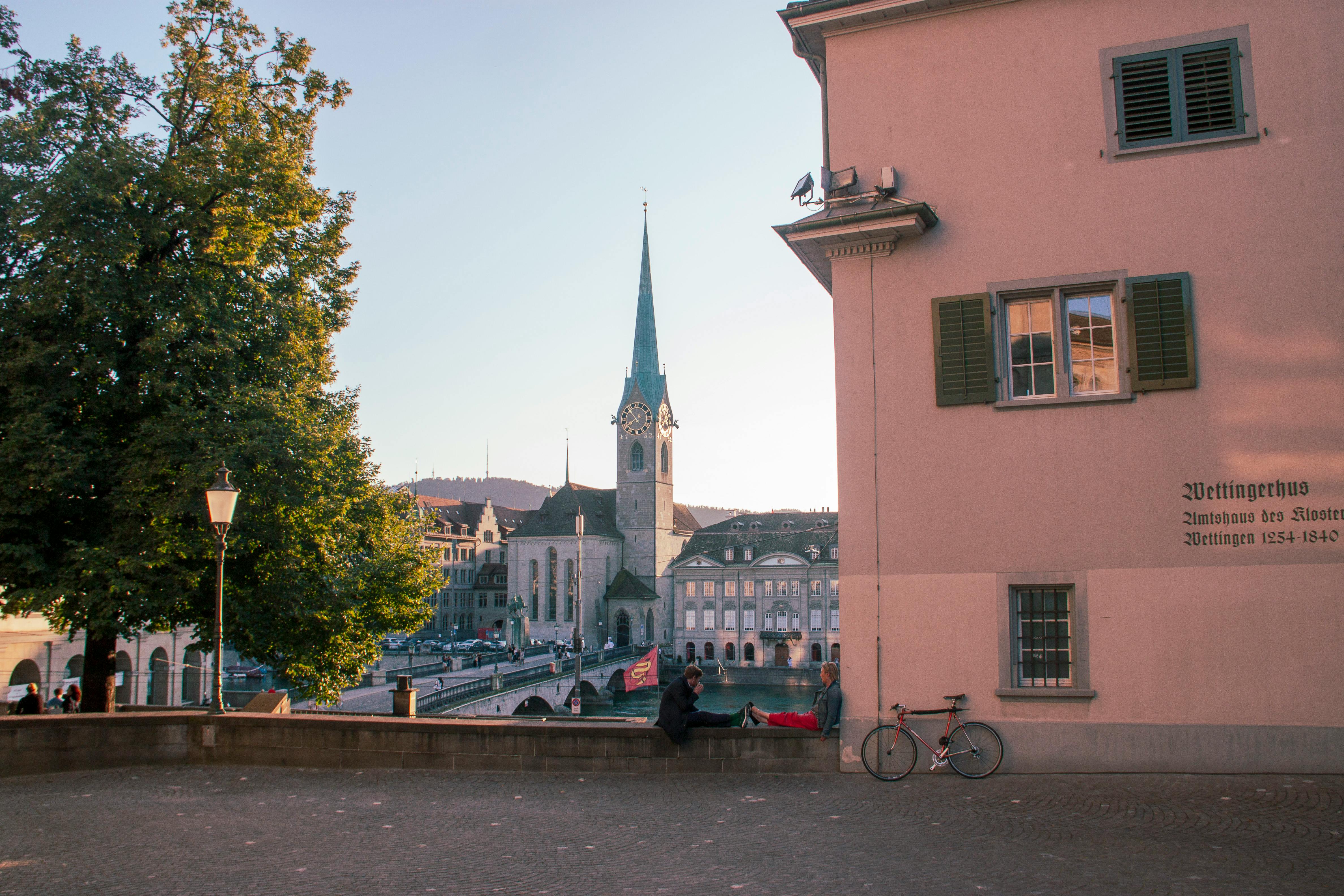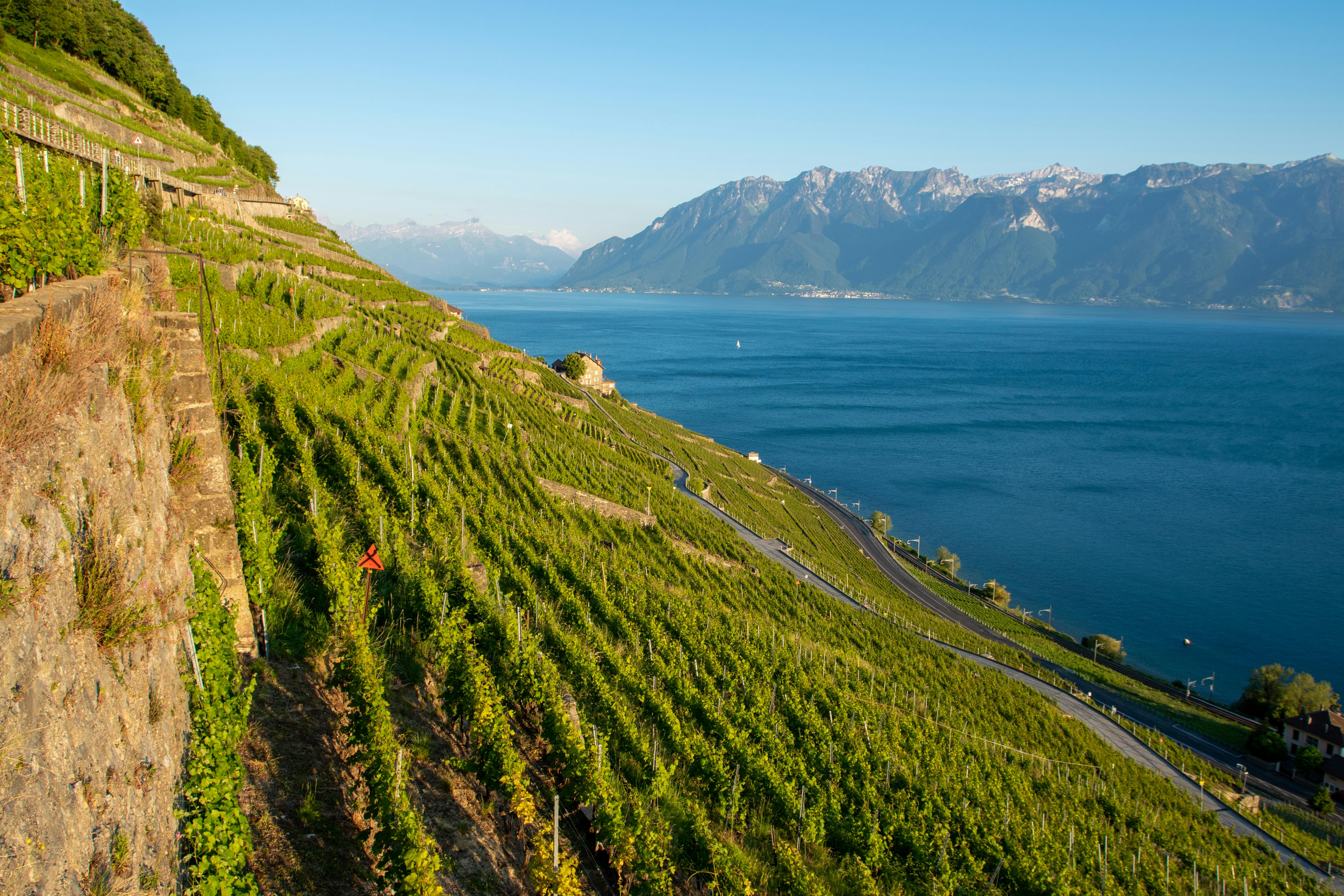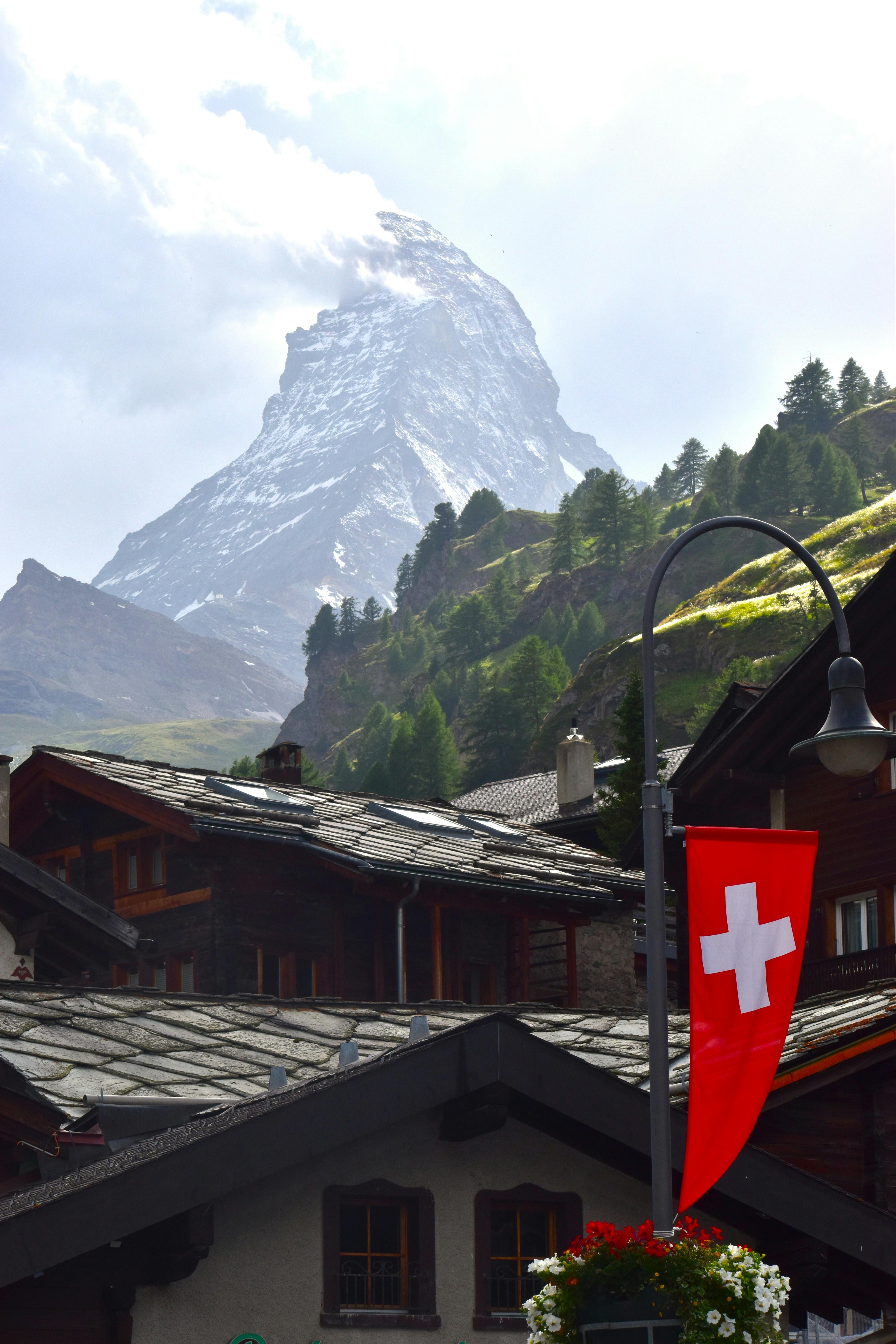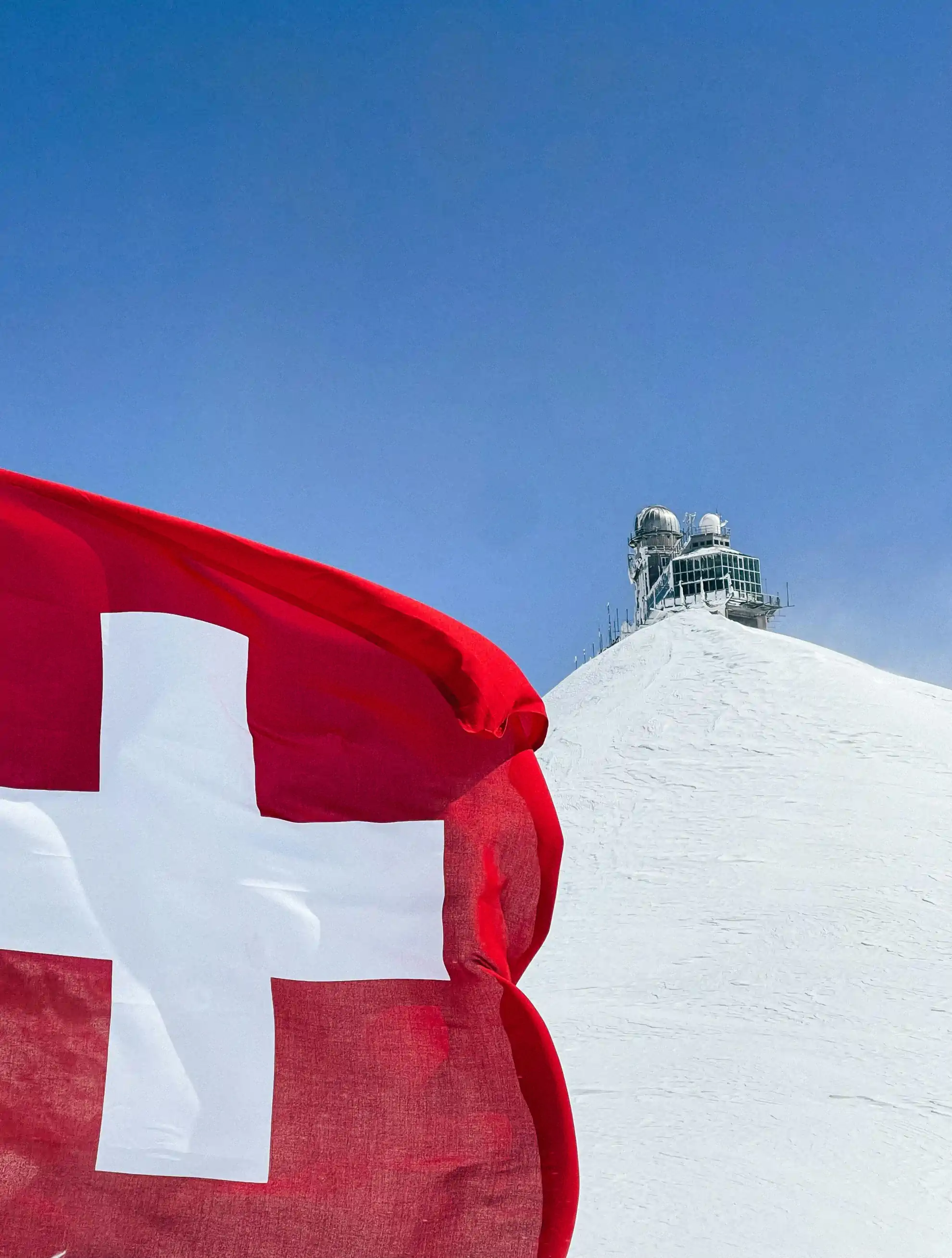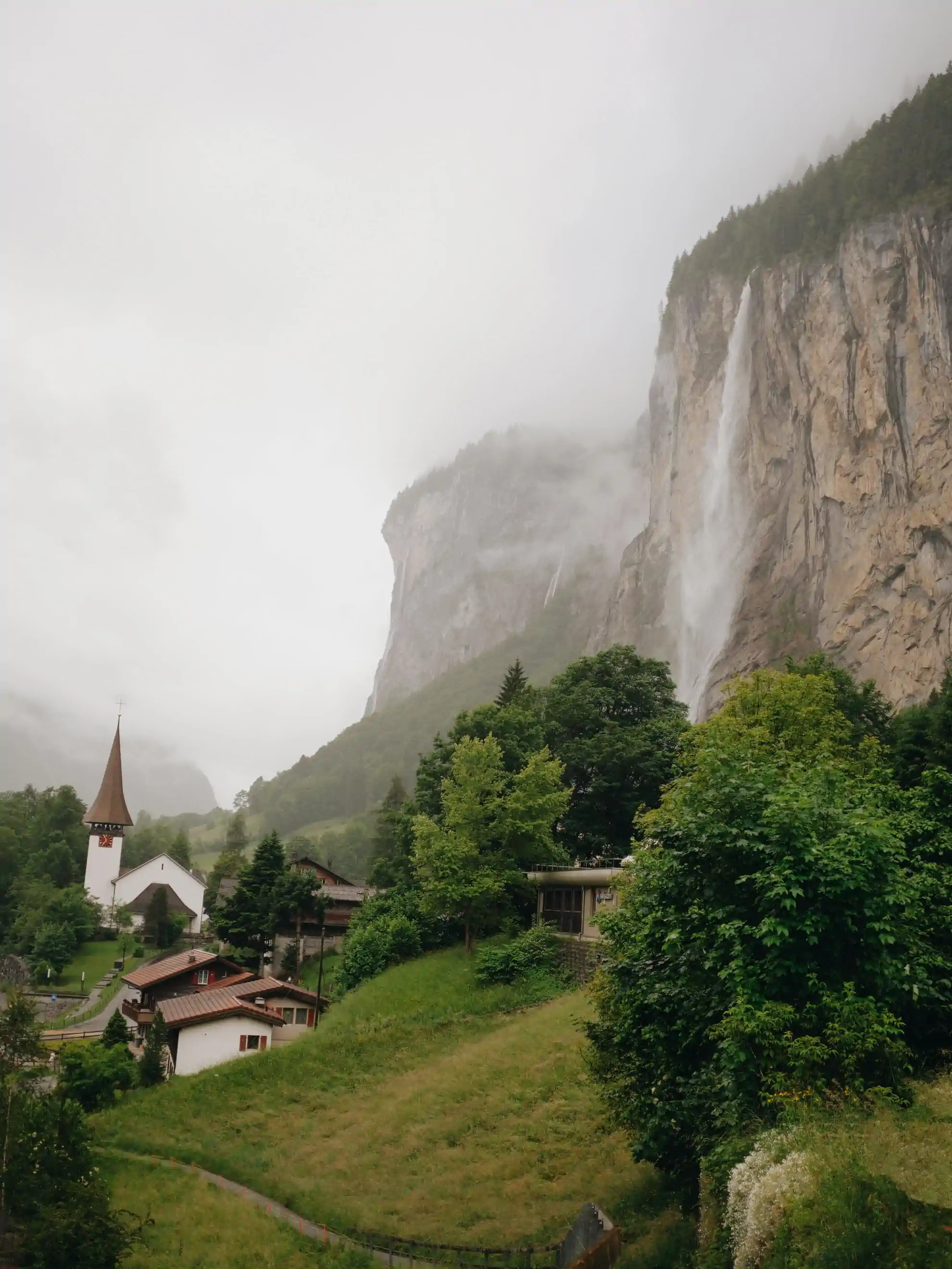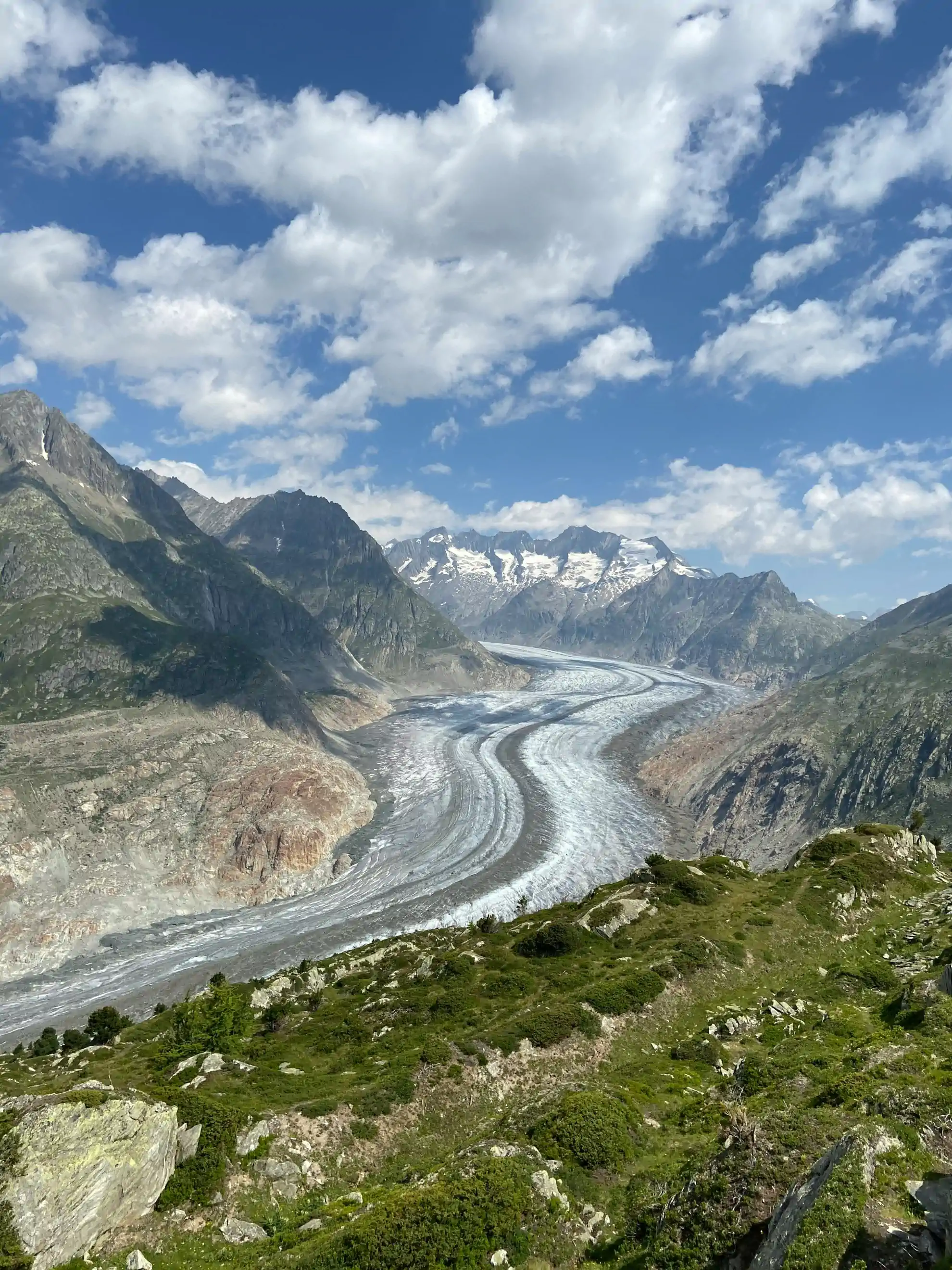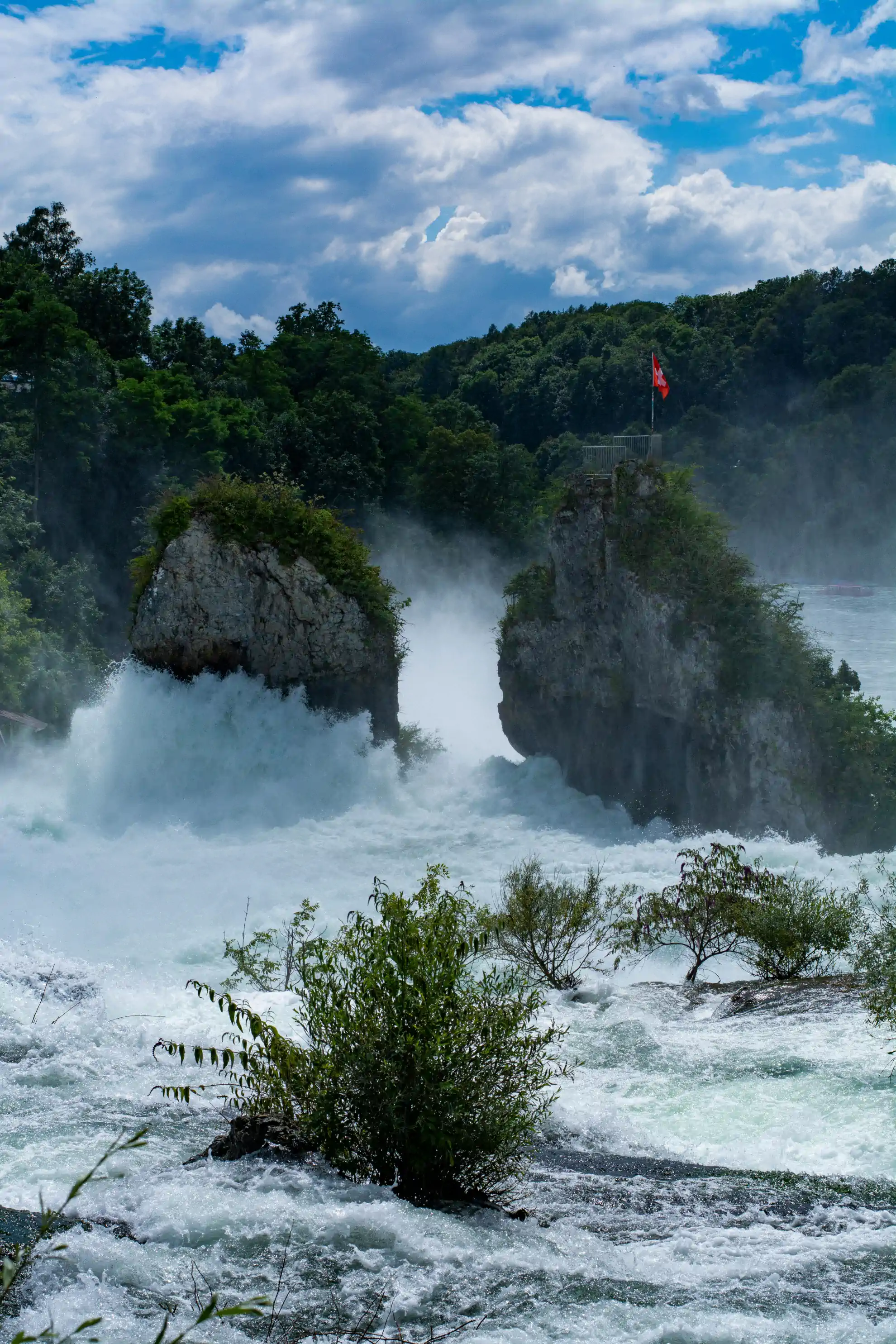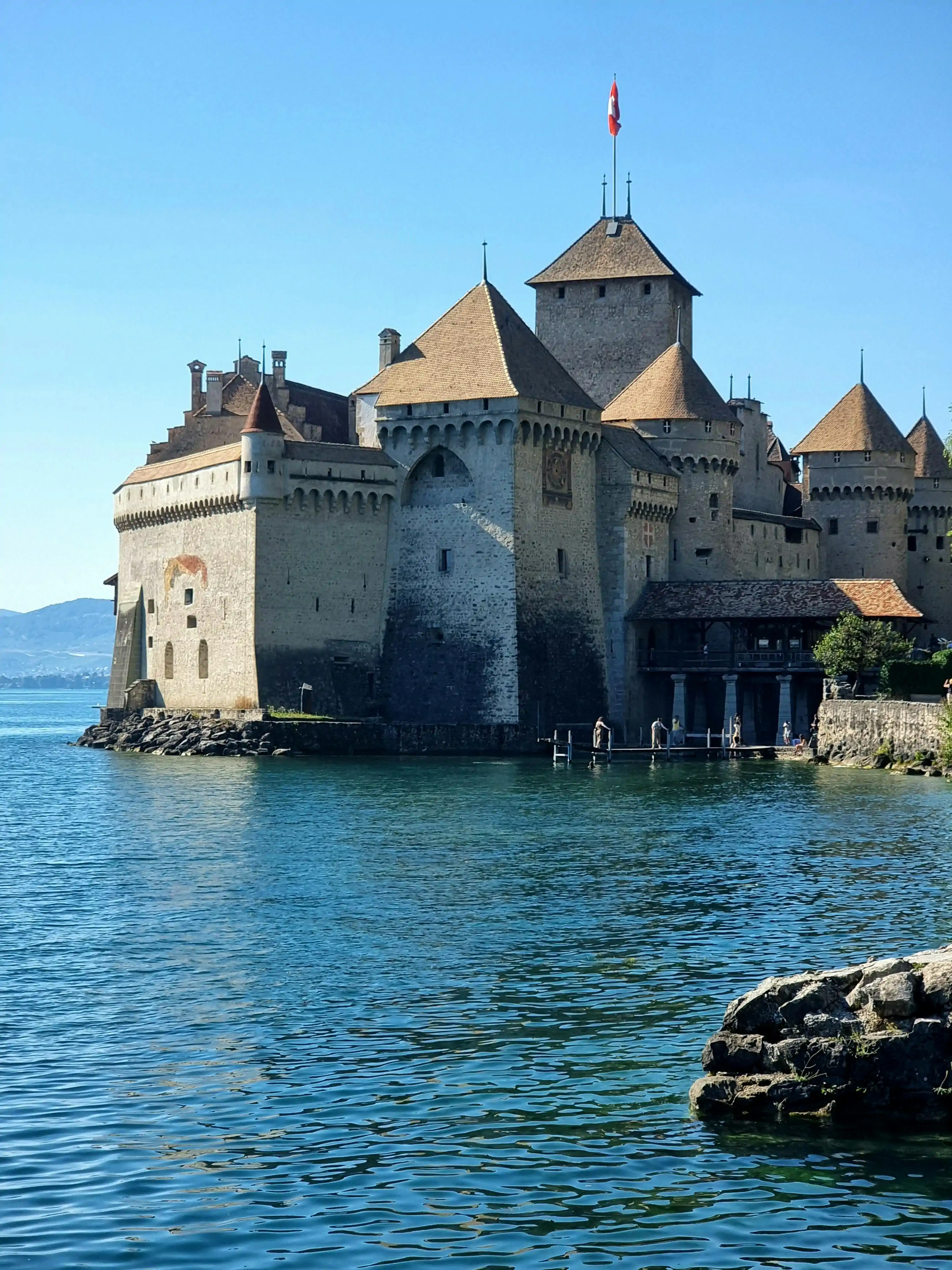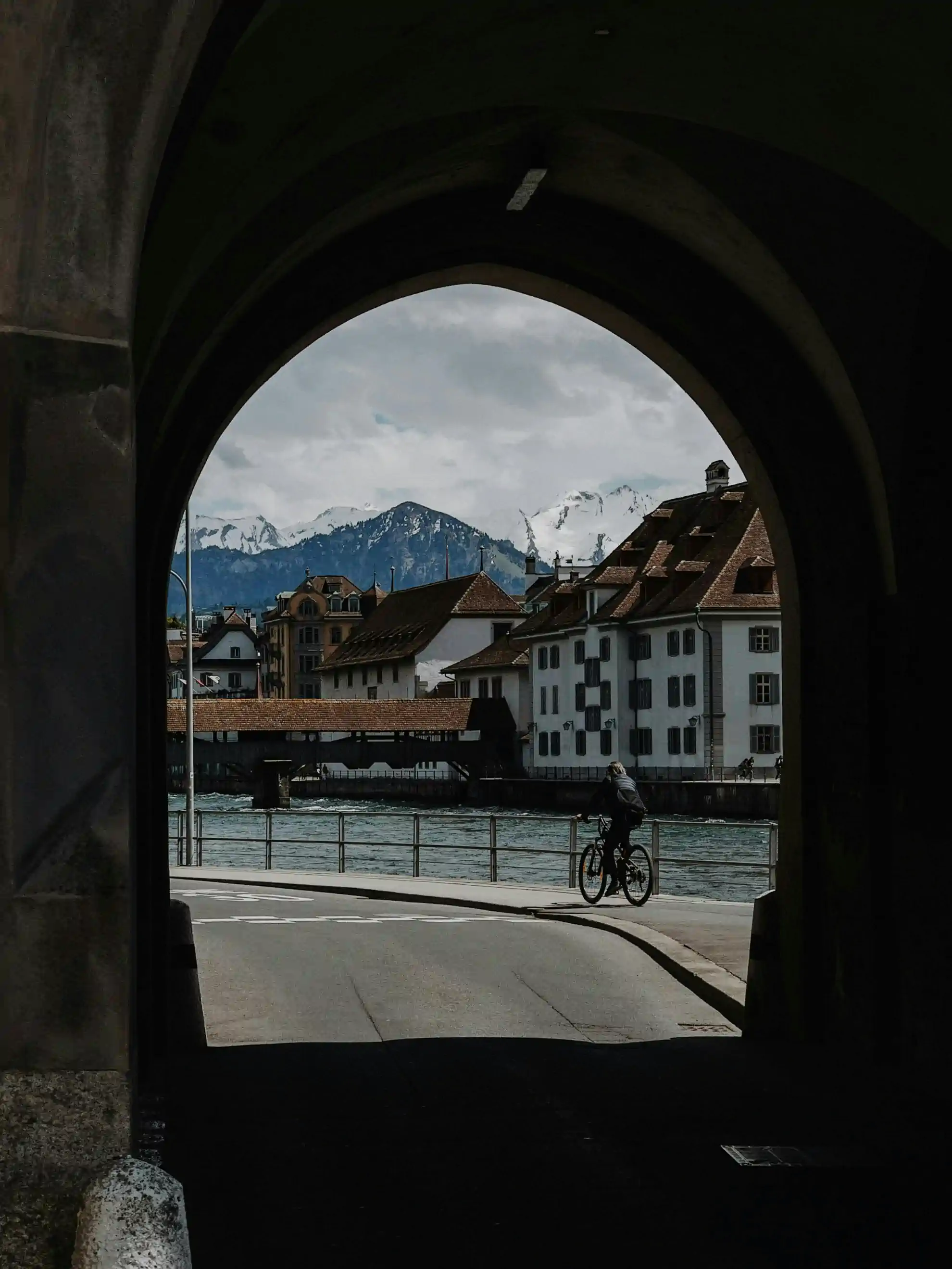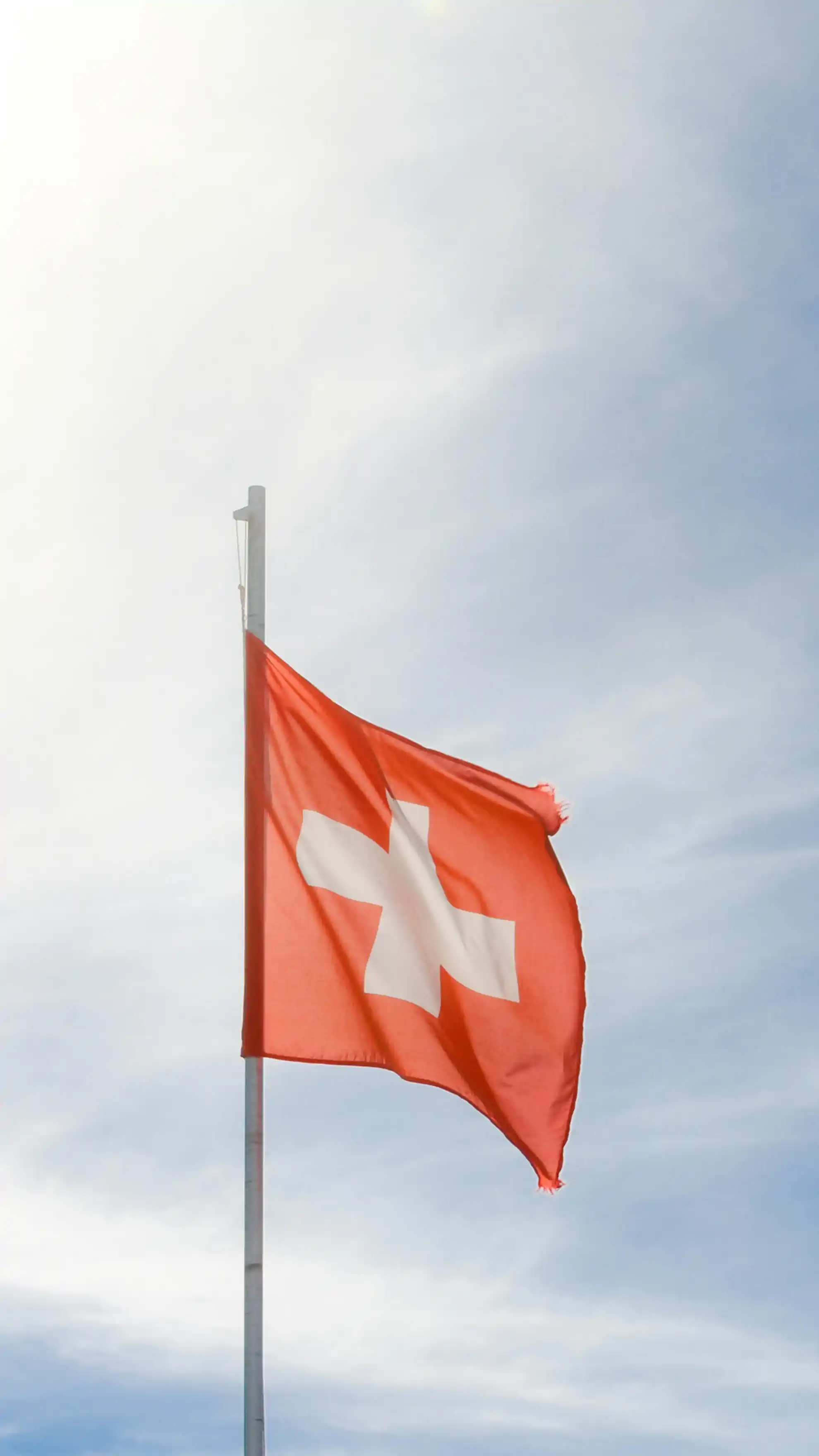Switzerland Country Guide.

Mountains. Around 70% of the national territory is mountainous.

Sun hours. More than 1.700 sun hours every year.

Best time to visit. The best time to visit Switzerland depends on the experience you’re seeking. Summer offers lush landscapes and outdoor adventures, while winter is perfect for skiing and snowy alpine charm.

Must see. Château de Chillon, The Matterhorn, Bern Old Town, Chapel Bridge Lucerne, Rheinfall, and much more ...
Must knowns about Switzerland.
Dive into the essence of Switzerland. From its stunning landscapes and rich history to its vibrant culture and dynamic economy, this section paints a vivid picture of what makes this nation unique. Explore the heart and soul of Switzerland, where every detail tells a story of tradition, innovation, and resilience.
Switzerland.
Switzerland, nestled in the heart of Europe, is renowned for its stunning alpine scenery, crystal-clear lakes, and charming villages that create a picture-perfect landscape.
The majestic Swiss Alps offer year-round adventures, from skiing and snowboarding in winter to hiking and mountain biking in summer.
The country is equally famous for its world-class gastronomy, featuring indulgent Swiss chocolate, fine cheeses, and traditional dishes like fondue and raclette.
Switzerland’s cities, like Zurich, Geneva, and Lucerne, blend modern sophistication with rich history, boasting art galleries, museums, and beautifully preserved medieval architecture.
For relaxation, the country’s luxurious spas, serene lakeside resorts, and tranquil mountain retreats provide the perfect escape.
With its blend of natural beauty, cultural heritage, and culinary delights, Switzerland offers a unique and unforgettable experience.
Visa requirements.
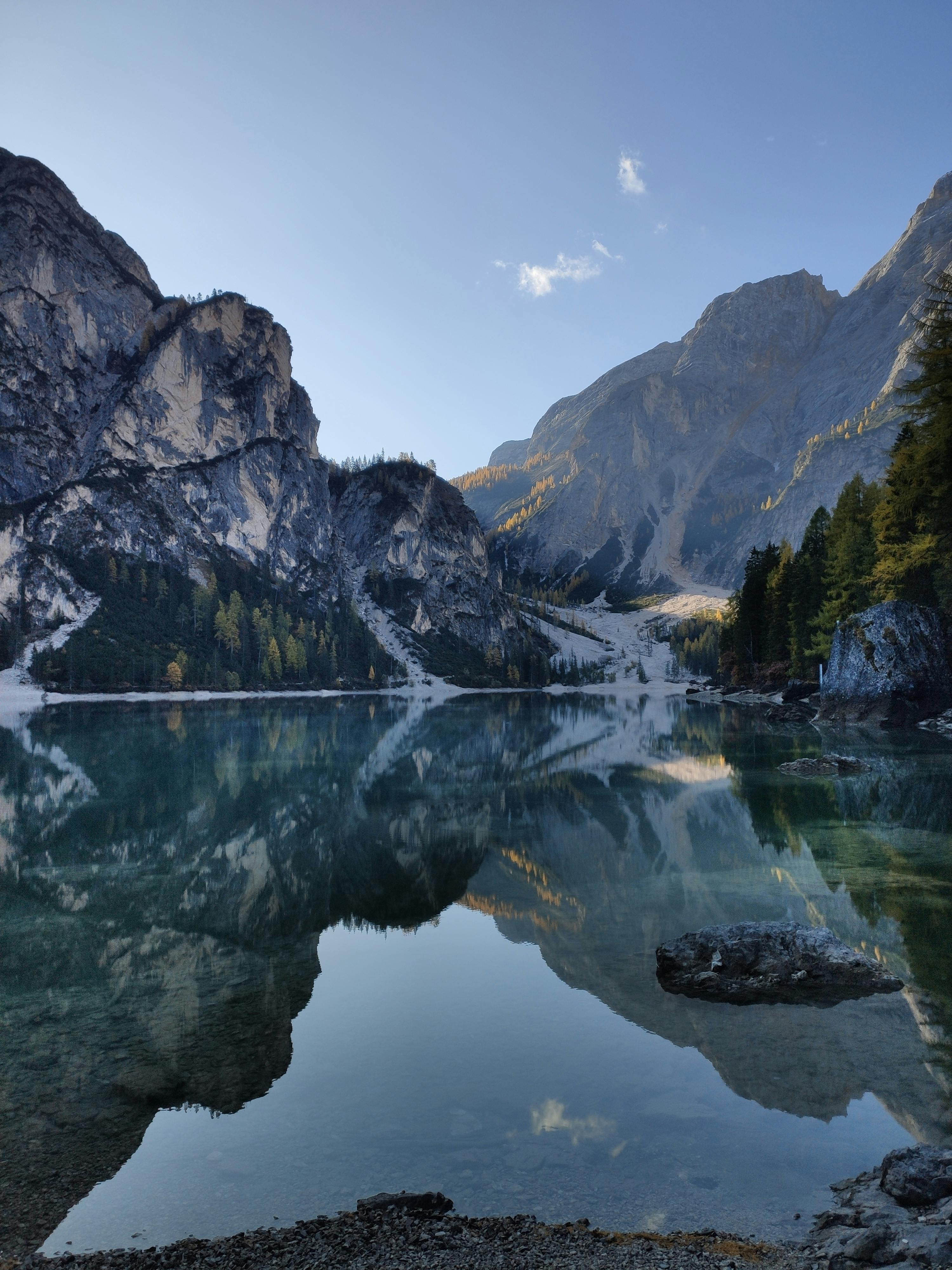
Short-Stay Visas (Schengen Visas).
A Schengen visa allows entry to Switzerland and other Schengen countries for up to 90 days within a 180-day period for tourism, business, family visits, or short-term study.
Who Needs a Schengen Visa?
- Non-EU/EEA/Swiss Nationals: Most non-EU/EEA/Swiss nationals need a Schengen visa to enter Switzerland.
- Visa-Exempt Countries: Citizens of certain countries, including the USA, Canada, Australia, New Zealand, Japan, and most South American nations, can enter Switzerland without a visa for up to 90 days within a 180-day period.
Requirements:
- Application Form: A completed and signed Schengen visa application form.
- Passport: Valid for at least three months beyond the intended date of departure from the Schengen Area, issued within the last 10 years, and with at least two blank pages.
- Photographs: Two recent passport-sized photos that meet Schengen photo requirements.
- Travel Insurance: Medical insurance with a minimum coverage of €30,000 for medical emergencies, repatriation, and hospital treatment, valid throughout the Schengen Area.
- Proof of Accommodation: Hotel bookings, an invitation letter from a host, or proof of accommodation.
- Proof of Financial Means: Bank statements, proof of employment, or a sponsorship letter showing sufficient funds for the duration of the stay (typically around CHF 100 per day).
- Flight Itinerary: Round-trip reservation or onward travel tickets.
- Supporting Documents: Additional documents might be required based on the visit's purpose, such as an invitation letter, conference registration, or business correspondence.
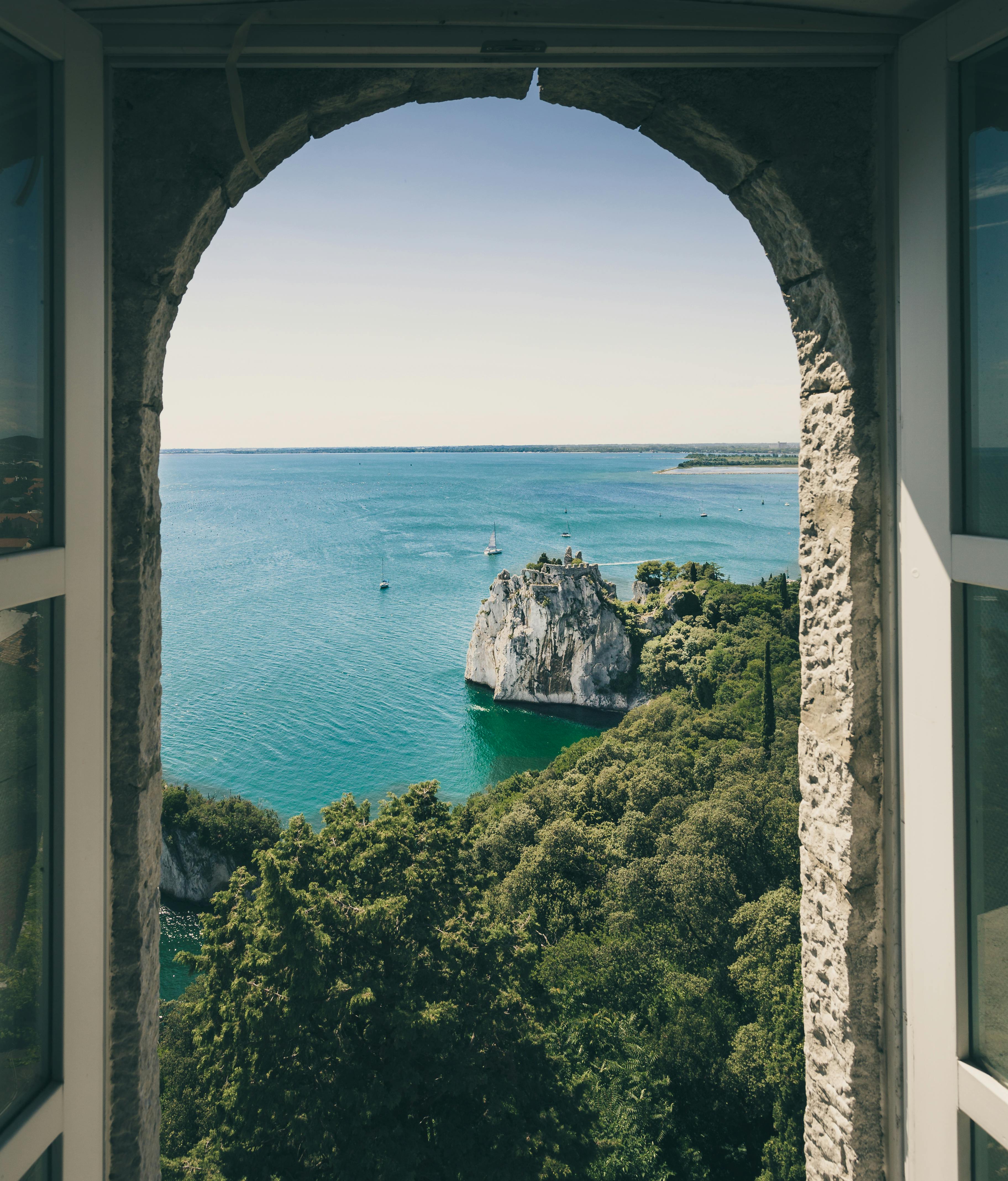
Long-Stay Visas (National Visas).
These visas are for stays longer than 90 days and are required for purposes like work, study, family reunification, or long-term residency.
Who Needs a National Visa?
- Non-EU/EEA nationals planning to stay in Switzerland for more than 90 days.
Requirements:
- Application Form: Completed and signed national visa application form.
- Passport: Valid for at least three months beyond the intended stay, with at least two blank pages.
- Photographs: Two recent passport-sized photos.
- Proof of Financial Means: Evidence of sufficient financial resources to cover the stay, such as bank statements, proof of employment, or a scholarship.
- Proof of Accommodation: Rental agreement, confirmation of housing in Switzerland, or an official accommodation letter.
- Health Insurance: Proof of health insurance that covers the entire duration of stay in Switzerland.
- Purpose-Specific Documents:
- Work Visa: An employment contract or work permit approved by the Swiss authorities.
- Student Visa: An acceptance letter from a recognized Swiss educational institution, proof of sufficient funds, and accommodation confirmation.
- Family Reunification: Proof of family ties (marriage or birth certificates) and evidence that the family member residing in Switzerland can support the applicant.
- Language Proficiency: Proof of language proficiency may be required, depending on the nature of the visa, such as study or work.
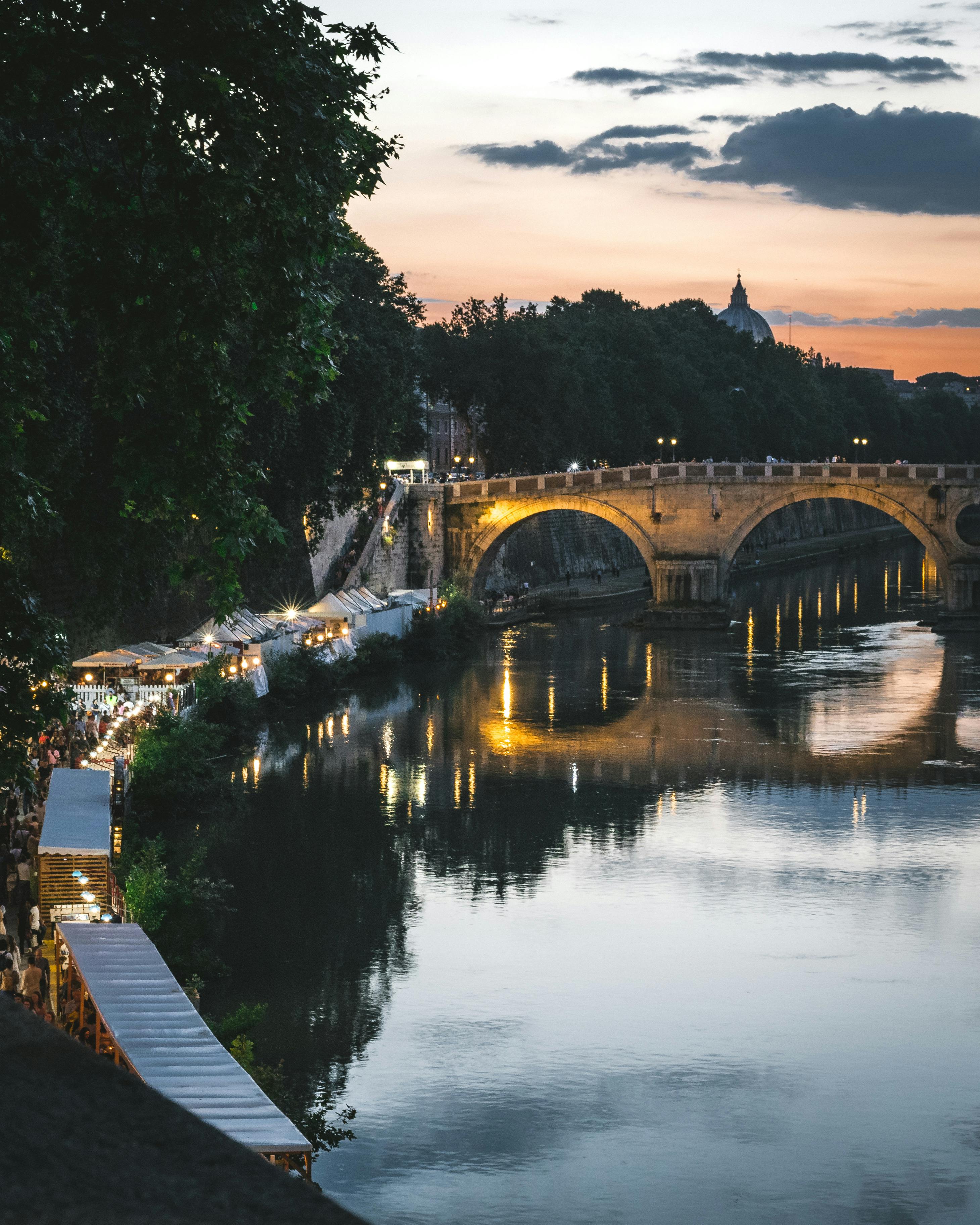
Transit Visas.
This visa is required for certain nationalities when transiting through a Swiss airport en route to a non-Schengen destination.
Who Needs a Transit Visa?
- Nationals of specific countries, such as Afghanistan, Bangladesh, Congo, Eritrea, Ghana, Iran, Iraq, Nigeria, Pakistan, Somalia, Sri Lanka, and Syria, among others, may need an airport transit visa.
Requirements:
- Application Form: Completed and signed.
- Passport: Valid with at least one blank page.
- Photographs: One or two recent passport-sized photos.
- Flight Ticket: Proof of onward flight to the final destination.
- Visa for Next Destination: If required, the visa for the country of the final destination.
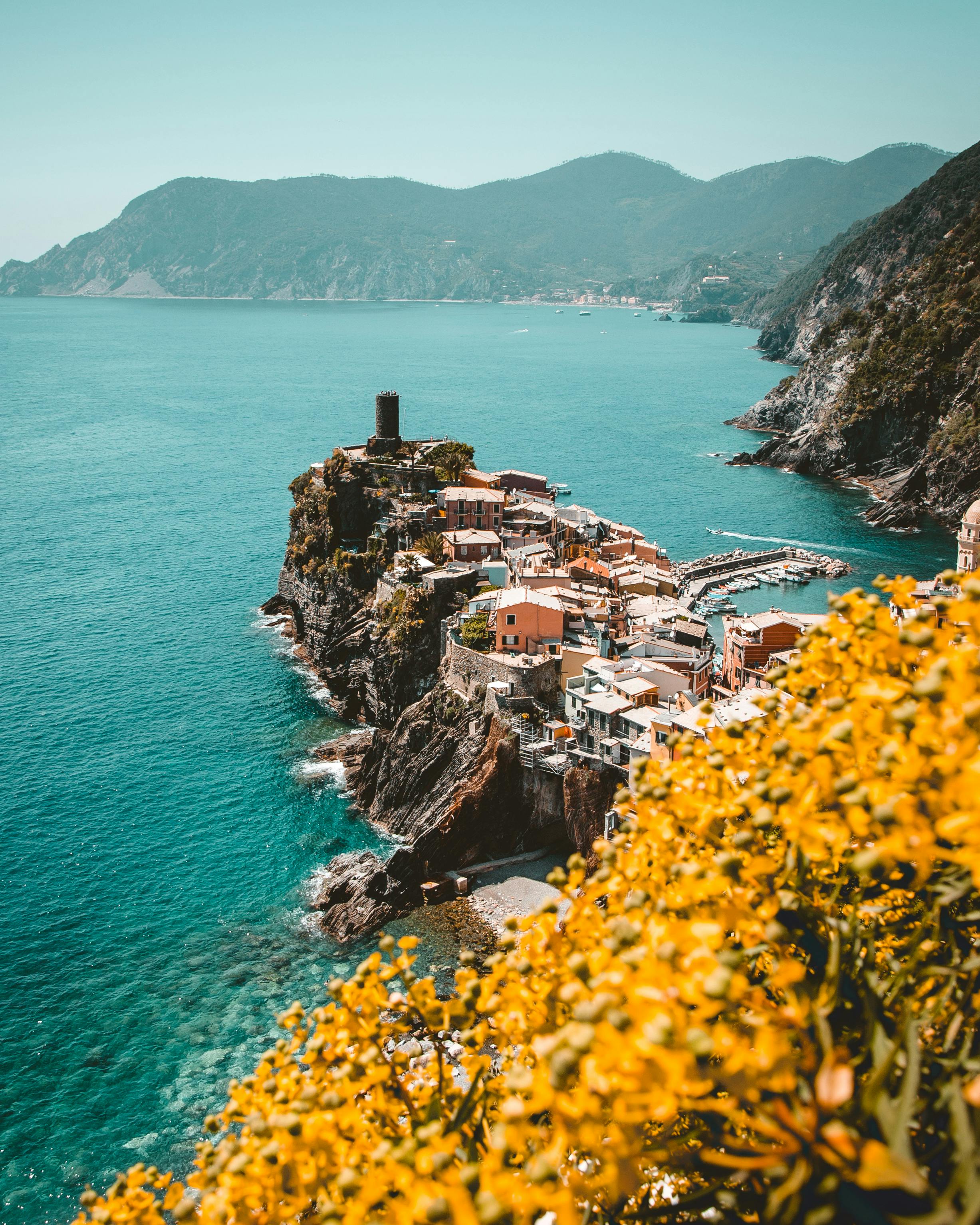
Special Cases.
EU/EEA Nationals: These citizens do not need a visa to enter, reside, work, or study in Switzerland.
Family Members of EU/EEA/Swiss Nationals: Depending on their nationality, they may need to apply for a visa or can benefit from simplified visa procedures.
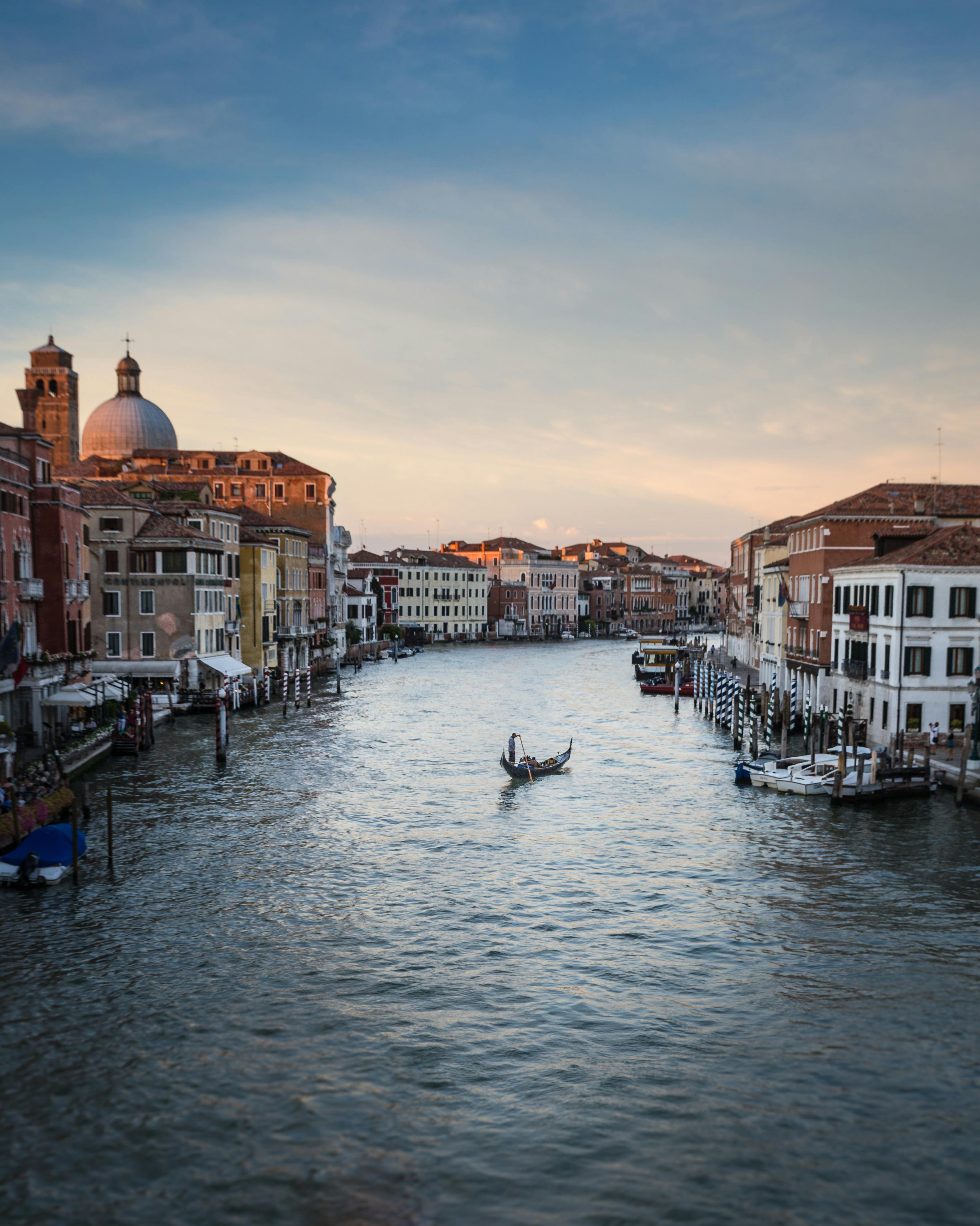
Application Process.
- Determine the Visa Type: Choose the appropriate visa based on the purpose and duration of the stay.
- Gather Required Documents: Collect the necessary documents according to the visa type.
- Complete the Application Form: Forms are available online or at the Swiss consulate/embassy.
- Schedule an Appointment: At the nearest Swiss consulate/embassy or visa application center.
- Submit the Application: Submit your application in person, including biometric data (fingerprints).
- Pay the Visa Fee: Fees vary depending on the type of visa and nationality.
- Wait for Processing: Schengen visas usually take about 15 calendar days, while national visas may take several weeks to a few months.
- Collect the Visa: Once approved, collect the visa from the consulate/embassy or visa application center.
Additional Notes.
- Multiple Entry Visa: If you need to travel in and out of the Schengen Area multiple times, you can request a multiple-entry visa.
- Visa Extensions: Schengen visas generally cannot be extended beyond 90 days except under exceptional circumstances. Long-stay visas may be extended depending on the situation.
It’s important to consult the Swiss embassy or consulate in your home country for the most accurate and up-to-date information, as visa requirements can change.
Safety in Switzerland.

General Safety.
- Low Crime Rate: Switzerland has a very low rate of violent crime. Most crime in Switzerland is non-violent, with petty theft being the most common issue, particularly in busy tourist areas, train stations, and crowded public transport.
- Pickpocketing and Scams: Pickpocketing can occur in major cities like Zurich, Geneva, and tourist spots. Always keep an eye on your belongings, especially in crowded places, and be cautious with ATMs and street vendors to avoid scams.

Health and Medical Care.
- High-Quality Healthcare: Switzerland has excellent healthcare facilities, and hospitals and clinics are equipped with modern technology and well-trained medical staff. EU/EEA citizens can use their European Health Insurance Card (EHIC) for healthcare services. Travelers from other countries should have travel insurance that covers medical expenses.
- Pharmacies: Pharmacies are widespread and well-stocked, offering over-the-counter medications and professional advice. Pharmacies are usually open during regular business hours, but some 24-hour options are available in larger cities.
- Vaccinations: No special vaccinations are required for entry into Switzerland, but it is recommended that routine vaccinations are up to date.

Natural Hazards and Environmental Considerations.
- Avalanches and Snow Safety: Switzerland's mountainous regions are prone to avalanches during winter. Always check weather and avalanche forecasts when skiing, snowboarding, or hiking. Follow marked trails and respect warning signs.
- Altitude Sickness: When traveling in high-altitude areas like the Swiss Alps, be aware of altitude sickness. Ascend gradually, stay hydrated, and avoid excessive physical exertion in the first few days.
- Floods and Landslides: During heavy rain or snowmelt, some areas may experience floods or landslides. Stay informed of weather updates, especially if you are traveling in rural or mountainous areas.
- Weather Conditions: Weather in Switzerland can change rapidly, especially in mountainous areas. Be prepared for sudden shifts in temperature, rain, or snow, even during summer.
- Clean and Green: Switzerland is known for its pristine environment. Littering is frowned upon and can result in fines. Follow local guidelines for waste disposal and respect nature.

Transportation Safety.
- Public Transportation: Switzerland’s public transport system is extremely safe, reliable, and well-maintained. Trains, buses, and trams are clean and punctual. However, be cautious of pickpockets in crowded areas.
- Road Safety: Roads in Switzerland are well-maintained, and traffic laws are strictly enforced. Be aware that driving in mountainous areas can be challenging due to narrow, winding roads. Winter conditions may require snow tires or chains.
- Cycling: Switzerland is very bike-friendly, with designated bike lanes and paths. However, always wear a helmet and follow road signs and signals.

Cultural Considerations.
- Respect for Local Customs: Swiss people value politeness, punctuality, and respect for privacy. It's important to greet people politely and be on time for appointments.
- Language Barrier: While English is widely spoken in tourist areas, the official languages are German, French, Italian, and Romansh. Learning a few basic phrases in the local language of the region you are visiting can be appreciated.

Emergency Contacts.
- Police: 117
- Ambulance: 144
- Fire Brigade: 118
- European Emergency Number (for all services): 112
Must-sees in Switzerland.
Prepare to embark on a journey through the most captivating and essential sites Switzerland has to offer. From majestic natural landscapes to historic marvels, these locations are the very heart and soul of Switzerland's allure.
Regions in Switzerland.
Immerse yourself in the captivating charm of Switzerland, where every region unfolds a unique tapestry of landscapes, culture, and history. From the snow-capped peaks of the Alps to the serene shores of its pristine lakes, the country offers a stunning array of settings, each with its own distinct character and allure.
Dive into the rich diversity that makes Switzerland a truly multifaceted destination, and explore the extraordinary range of experiences that await across its enchanting regions. Discover what makes each part of Switzerland a world of its own.

Bern.
Florence.
Florence, a Renaissance jewel, dazzles with Michelangelo’s David, the Duomo, and art in the Uffizi Gallery, all set in charming, historic streets.
Val d’Orcia.
Val d’Orcia, a scenic Tuscan valley, delights with rolling hills, medieval towns, and fine wines, showcasing Italy’s serene rural charm.
Cascate del Mulino.
Cascate del Mulino features enchanting natural hot springs cascading into picturesque pools, offering a tranquil retreat amid stunning countryside.
Discover the allure of the Bern region, where Switzerland’s rich heritage and natural splendor converge to create an unforgettable luxury experience. Nestled in the heart of Switzerland, Bern boasts a temperate climate that offers pleasant summers and picturesque winters, ideal for year-round exploration.
This region is renowned for its cultural treasures, including the charming medieval Old Town of Bern, a UNESCO World Heritage site, with its well-preserved architecture and iconic Zytglogge clock tower.
The region’s diverse landscapes offer opulent retreats, from the pristine lakeside resorts of Thun to the upscale Alpine resorts of Adelboden and Gstaad.
Indulge in gourmet dining at fine restaurants, explore world-class art at the Bern Kunstmuseum, or relax in luxury spas with panoramic mountain views.
With its combination of historical richness and modern elegance, Bern presents an exceptional destination for discerning travelers seeking a blend of culture, luxury, and natural beauty.
Bern.
Sadly we are not able to show you all activities. But let the three activities below give you a small tip and insight in what is possible.
Get in contact with us to discover more about what is possible.
Central Switzerland.
Florence.
Florence, a Renaissance jewel, dazzles with Michelangelo’s David, the Duomo, and art in the Uffizi Gallery, all set in charming, historic streets.
Val d’Orcia.
Val d’Orcia, a scenic Tuscan valley, delights with rolling hills, medieval towns, and fine wines, showcasing Italy’s serene rural charm.
Cascate del Mulino.
Cascate del Mulino features enchanting natural hot springs cascading into picturesque pools, offering a tranquil retreat amid stunning countryside.
Central Switzerland offers an escape into a realm of natural beauty and cultural richness. This region, known for its stunning alpine vistas and picturesque lakes, enjoys a temperate climate with warm summers and snowy winters, making it a year-round destination.
Explore the elegant town of Lucerne, renowned for its historic Chapel Bridge and vibrant arts scene, or take a scenic cruise on Lake Lucerne, surrounded by majestic mountains. The area is also home to the exclusive resort town of Engelberg, where you can enjoy premier skiing and world-class spa facilities. The charming town of Weggis, nestled by the lake, provides a tranquil retreat with panoramic views and gourmet dining experiences.
Central Switzerland’s unique selling points include its blend of natural splendor and refined luxury, offering discerning travelers an exceptional mix of relaxation, adventure, and cultural immersion.
Central Switzerland activities.
Sadly we are not able to show you all activities. But let the three activities below give you a small tip and insight in what is possible.
Get in contact with us to discover more about what is possible.
Eastern Switzerland.
Florence.
Florence, a Renaissance jewel, dazzles with Michelangelo’s David, the Duomo, and art in the Uffizi Gallery, all set in charming, historic streets.
Val d’Orcia.
Val d’Orcia, a scenic Tuscan valley, delights with rolling hills, medieval towns, and fine wines, showcasing Italy’s serene rural charm.
Cascate del Mulino.
Cascate del Mulino features enchanting natural hot springs cascading into picturesque pools, offering a tranquil retreat amid stunning countryside.
Eastern Switzerland invites discerning travelers to explore its diverse landscapes and rich cultural heritage. This region, characterized by its stunning alpine scenery and charming towns, enjoys a temperate climate with mild summers and crisp winters, perfect for a variety of luxury experiences throughout the year.
Discover the elegance of St. Moritz, renowned for its high-end shopping and world-class winter sports, or visit the picturesque town of Appenzell, celebrated for its traditional Swiss architecture and artisanal cheese.
The vibrant city of St. Gallen offers a unique blend of historical architecture and modern sophistication, highlighted by its UNESCO-listed Abbey Library. For a serene retreat, the Engadine Valley provides breathtaking mountain views and exclusive wellness resorts.
Eastern Switzerland’s unique selling points include its blend of natural beauty, cultural depth, and luxury offerings, creating a distinctive and memorable experience for travelers seeking both adventure and relaxation.
Eastern Switzerland activities.
Sadly we are not able to show you all activities. But let the three activities below give you a small tip and insight in what is possible.
Get in contact with us to discover more about what is possible.
Lake Geneva Region.
Florence.
Florence, a Renaissance jewel, dazzles with Michelangelo’s David, the Duomo, and art in the Uffizi Gallery, all set in charming, historic streets.
Val d’Orcia.
Val d’Orcia, a scenic Tuscan valley, delights with rolling hills, medieval towns, and fine wines, showcasing Italy’s serene rural charm.
Cascate del Mulino.
Cascate del Mulino features enchanting natural hot springs cascading into picturesque pools, offering a tranquil retreat amid stunning countryside.
The Lake Geneva Region captivates with its blend of sophistication and natural beauty. This area, characterized by its stunning lakeside setting and luxurious charm, enjoys a mild climate with warm summers and crisp winters, making it a prime destination year-round.
Explore Geneva’s cosmopolitan atmosphere, where you can indulge in high-end shopping, fine dining, and exclusive cultural experiences such as private tours of the Red Cross Museum and the Jet d'Eau fountain. Lausanne offers a perfect mix of elegance and history with its renowned Olympic Museum and vibrant cultural scene. Montreux, famed for its annual Montreux Jazz Festival, provides a scenic backdrop with its lakeside promenades and luxury hotels.
The region’s unique selling points include its world-class amenities, picturesque landscapes, and a rich cultural tapestry that promises both relaxation and sophisticated engagement.
Lake Geneva Region activities.
Sadly we are not able to show you all activities. But let the three activities below give you a small tip and insight in what is possible.
Get in contact with us to discover more about what is possible.
Ticino.
Florence.
Florence, a Renaissance jewel, dazzles with Michelangelo’s David, the Duomo, and art in the Uffizi Gallery, all set in charming, historic streets.
Val d’Orcia.
Val d’Orcia, a scenic Tuscan valley, delights with rolling hills, medieval towns, and fine wines, showcasing Italy’s serene rural charm.
Cascate del Mulino.
Cascate del Mulino features enchanting natural hot springs cascading into picturesque pools, offering a tranquil retreat amid stunning countryside.
Ticino, the Italian-speaking region of Switzerland, offers an alluring blend of Mediterranean charm and Swiss sophistication.
Renowned for its stunning lakes, vibrant culture, and picturesque landscapes, Ticino enjoys a mild climate with warm summers and mild winters, making it an ideal destination throughout the year. Explore Lugano’s upscale shops and lakeside promenades, or visit Bellinzona, famous for its medieval castles that are UNESCO World Heritage sites.
The region's scenic beauty extends to Lake Maggiore, where luxurious lakeside resorts and exclusive boat cruises provide unparalleled relaxation. For a unique experience, indulge in a private tour of the Verzasca Valley, known for its emerald-green river and striking natural rock formations.
Ticino’s unique selling points include its Italian flair, amenities, and the seamless integration of cultural richness with natural beauty, offering an exceptional experience for travelers seeking elegance and tranquility.
Ticino activities.
Sadly we are not able to show you all activities. But let the three activities below give you a small tip and insight in what is possible.
Get in contact with us to discover more about what is possible.
Valais.
Florence.
Florence, a Renaissance jewel, dazzles with Michelangelo’s David, the Duomo, and art in the Uffizi Gallery, all set in charming, historic streets.
Val d’Orcia.
Val d’Orcia, a scenic Tuscan valley, delights with rolling hills, medieval towns, and fine wines, showcasing Italy’s serene rural charm.
Cascate del Mulino.
Cascate del Mulino features enchanting natural hot springs cascading into picturesque pools, offering a tranquil retreat amid stunning countryside.
Valais, nestled in the heart of the Swiss Alps, offers a luxurious blend of natural grandeur and refined elegance.
This region, characterized by its dramatic mountain landscapes and sunny climate, is renowned for its world-class ski resorts, charming alpine villages, and exceptional outdoor activities. Explore the renowned resort town of Zermatt, with its breathtaking views of the iconic Matterhorn and exclusive shopping and dining experiences.
The town of Saas-Fee, often called the “Pearl of the Alps,” features a car-free village and offers pristine skiing and glacier hiking. The historic town of Sion boasts medieval architecture and a rich cultural heritage, while the thermal spas of Leukerbad provide unparalleled relaxation in a stunning alpine setting.
Valais’s unique selling points include its diverse landscapes, luxurious amenities, and a wealth of high-end experiences that combine outdoor adventure with sophisticated leisure.
Valais activities.
Sadly we are not able to show you all activities. But let the three activities below give you a small tip and insight in what is possible.
Get in contact with us to discover more about what is possible.

Zurich.
Florence.
Florence, a Renaissance jewel, dazzles with Michelangelo’s David, the Duomo, and art in the Uffizi Gallery, all set in charming, historic streets.
Val d’Orcia.
Val d’Orcia, a scenic Tuscan valley, delights with rolling hills, medieval towns, and fine wines, showcasing Italy’s serene rural charm.
Cascate del Mulino.
Cascate del Mulino features enchanting natural hot springs cascading into picturesque pools, offering a tranquil retreat amid stunning countryside.
Zurich, Switzerland's vibrant financial and cultural hub, seamlessly blends cosmopolitan sophistication with picturesque charm. Renowned for its elegant boutiques, high-end dining, and vibrant cultural scene, Zurich offers a range of luxury experiences set against a backdrop of stunning landscapes.
Explore the historic Altstadt (Old Town) with its medieval architecture, visit the Kunsthaus Zurich for a taste of world-class art, and stroll along Bahnhofstrasse, one of the world’s most exclusive shopping streets. The city’s proximity to the pristine Lake Zurich and the nearby Uetliberg mountain provides ample opportunities for upscale outdoor activities and breathtaking views. In winter, the region transforms into a winter wonderland, perfect for luxury skiing and après-ski experiences.
Zurich’s unique selling points include its fusion of modernity with historic charm, its status as a global financial center, and its unparalleled quality of life, making it a premier destination for travelers seeking both elegance and adventure.
Zurich activities.
Sadly we are not able to show you all activities. But let the three activities below give you a small tip and insight in what is possible.
Get in contact with us to discover more about what is possible.
Gastronomy in Switzerland.
Explore the culinary delights of Switzerland, where you'll find famous recipes, top restaurants, and celebrated chefs. This guide offers a taste of the nation’s rich food culture, but remember, there’s a whole world of flavors and dining experiences beyond these highlights. Dive in and let your palate and eyes discover famous recipes, top restaurants, and celebrated chefs.
Famous dishes.
Fondue.
Fondue is an iconic Swiss dish where a pot of melted cheese, often Gruyère or Emmental, is enjoyed with crusty bread. The cheese is melted with white wine and a hint of garlic, offering a creamy, rich dip that's perfect for communal dining and reflects Switzerland's deep culinary traditions.
Rösti.
Rösti is a beloved Swiss potato dish that resembles crispy hash browns. Shredded potatoes are pan-fried until golden brown, creating a crunchy exterior and a soft interior. Originally a breakfast staple in the German-speaking part of Switzerland, Rösti has become a versatile side dish enjoyed throughout the country.
Raclette.
Raclette features melted cheese scraped over boiled potatoes, pickles, and cured meats. The cheese, traditionally Raclette, is melted using a special grill or oven and then poured over the accompaniments, offering a warm and comforting meal that's especially popular during winter.
Zürcher Geschnetzeltes.
Zürcher Geschnetzeltes is a classic Zurich dish made with tender strips of veal cooked in a creamy white wine and mushroom sauce. Served with Rösti, this dish combines rich flavors and textures, showcasing the regional preference for hearty and luxurious meal
Älplermagronen.
Älplermagronen is a Swiss alpine comfort dish that blends pasta, potatoes, and cheese into a creamy, satisfying casserole. Typically topped with crispy onions and served with applesauce, Älplermagronen reflects the hearty, rustic cuisine of the Swiss Alps.
Swiss Chasseral.
Swiss Chasseral is a traditional dish made from tender beef braised with vegetables and a full-bodied red wine. Known for its rich, complex flavors and succulent meat, it is a staple of Swiss home cooking and often enjoyed during festive occasions.
Tartiflette.
Tartiflette combines potatoes, reblochon cheese, bacon, and onions in a gratin-like dish. This French-influenced recipe is popular in Swiss Alpine regions, providing a rich, indulgent meal that's perfect for warming up after a day on the slopes.
Sausage and Sauerkraut.
Sausage and Sauerkraut reflects Switzerland's influence from neighboring Germany, featuring juicy sausages served with tangy sauerkraut. This dish combines savory, spiced meats with fermented cabbage, creating a flavorful and hearty meal that's widely appreciated across Switzerland.
Saffron Risotto.
Saffron Risotto is a luxurious Swiss dish featuring creamy risotto infused with aromatic saffron threads. This Italian-inspired dish is elevated with Swiss cheeses and often garnished with fresh herbs, showcasing a refined approach to comfort food.
Swiss Chasseral.
Swiss Chasseral is a distinctive dish featuring a rich combination of meats and seasonal vegetables, slow-cooked to perfection. This robust and hearty stew is a testament to Switzerland's tradition of flavorful, satisfying meals.
Famous Swiss Chefs.
Andreas Caminada.
Known for his avant-garde style, Caminada blends traditional Swiss flavors with modern techniques at his three-Michelin-starred restaurant Schloss Schauenstein in Fürstenau. His approach emphasizes local ingredients, artistic presentation, and innovative dishes, making him a leader in Switzerland's culinary scene.
Daniel Humm.
Humm’s style is refined, minimalist, and deeply rooted in farm-to-table philosophy. As the chef of Eleven Madison Park in New York, Humm crafts elegant, vegetable-forward dishes that highlight pure flavors. His meticulous attention to detail and sustainability-focused approach set him apart.
Heiko Nieder.
Chef at The Restaurant at The Dolder Grand in Zurich, Nieder’s cuisine is celebrated for its creativity, bold flavors, and precision. His two-Michelin-starred restaurant offers a modern European menu with a touch of Asian influences, making him a standout in contemporary gastronomy.
Tanja Grandits.
Head chef at Stucki in Basel, Grandits is known for her vibrant, color-themed dishes and innovative use of herbs and spices. Her playful, aromatic style blends traditional and modern elements, earning her two Michelin stars and recognition as one of Switzerland’s most creative chefs.
Peter Knogl.
At the helm of the three-Michelin-starred Cheval Blanc in Basel, Knogl’s style is elegant, sophisticated, and influenced by French haute cuisine. His dishes are known for their balance, subtlety, and flawless execution, making him a master of refined gastronomy.
Didier de Courten.
Leading chef at Le Terminus in Sierre, de Courten’s cuisine is rooted in precision and creativity. Known for his artistic presentation and meticulous use of local ingredients, his dishes reflect a harmonious blend of classic and contemporary techniques, earning him two Michelin stars.
Dominique Gauthier.
As the chef of Le Chat Botté at Beau-Rivage in Geneva, Gauthier’s style is refined, elegant, and heavily influenced by Mediterranean flavors. His focus on seasonal ingredients and light, yet sophisticated dishes has garnered widespread acclaim and a Michelin star.
Stefan Heilemann.
Chef at Ecco Zurich, Heilemann’s cuisine is inventive, bold, and characterized by intricate flavor combinations. His meticulous approach to cooking, along with a flair for exotic ingredients, has earned him two Michelin stars and a reputation for culinary excellence.
Franck Giovannini.
At Hôtel de Ville in Crissier, Giovannini continues the legacy of one of the world’s most renowned restaurants. His style is classic French with modern twists, focusing on pure flavors and seasonal ingredients. His work upholds the restaurant’s three-Michelin-star status with finesse.
Michelin star restaurants.
Key information about the restaurant.
- Cuisine Style: Bistronomy, French Bistro.
- Cuisine Style: Molecular Gastronomy with Greek influences
- Most Famous Dish: “Greek Salad” reimagined in molecular form
- Accessible for Wheelchairs: Yes
- Pricing Range: €200 - €300 per person
- Link to website.
Funky Gourmet (Athens).
Funky Gourmet is known for its avant-garde cuisine that blends Greek flavors with molecular gastronomy. Co-owned by chefs Georgianna Hiliadaki and Nikos Roussos, it offers a multi-sensory dining experience where art meets food. Dishes are highly conceptual and creative, often pushing the boundaries of traditional Greek cuisine in a modern, playful way.
Key information about the restaurant.
- Cuisine Style: Modern Greek and Mediterranean
- Most Famous Dish: Black Cod with Miso and Lemongrass
- Accessible for Wheelchairs: Yes
- Pricing Range: €150 - €250 per person
- Link to website.
Botrini’s (Athens).
Helmed by renowned chef Ektoras Botrini, Botrini’s offers a creative interpretation of Greek and Mediterranean cuisine. Located in the leafy suburb of Chalandri, it combines technical precision with artistic presentation. The restaurant’s menu is inspired by local ingredients and traditional recipes, delivered with a modern twist.
Key information about the restaurant.
- Cuisine Style: Innovative Greek Seafood
- Most Famous Dish: Squid Ink Risotto with Fresh Seafood
- Accessible for Wheelchairs: Yes
- Pricing Range: €100 - €150 per person
- Link to website.
Varoulko Seaside (Piraeus, Athens).
Varoulko Seaside, run by Michelin-starred chef Lefteris Lazarou, is a seafood lover’s paradise. Located by the marina, the restaurant offers stunning sea views and a menu that elevates traditional Greek seafood dishes with a refined, contemporary twist, emphasizing fresh, local ingredients.
Key information about the restaurant.
- Cuisine Style: Modern Greek
- Most Famous Dish: Lamb with Yogurt and Herbs
- Accessible for Wheelchairs: Yes
- Pricing Range: €120 - €180 per person
- Link to website.
Hytra (Athens).
Hytra blends traditional Greek flavors with modern techniques, offering a refined dining experience with breathtaking views of the Acropolis. Known for its inventive presentations and emphasis on seasonal ingredients, Hytra provides a journey through Greece’s culinary history, interpreted in a contemporary fashion.
Key information about the restaurant.
- Cuisine Style: French-inspired with Greek influences
- Most Famous Dish: Foie Gras with Greek Honey and Figs
- Accessible for Wheelchairs: Limited Accessibility
- Pricing Range: €140 - €200 per person
- Link to website.
Spondi (Athens).
A cornerstone of fine dining in Athens, Spondi offers a blend of French and Greek influences under the guidance of chef Angelos Lantos. The elegant ambiance, combined with meticulous presentations and a menu focused on high-quality ingredients, makes Spondi a top destination for gastronomes.
Key information about the restaurant.
- Cuisine Style: Modern Cycladic
- Most Famous Dish: Fava Bean Puree with Capers and Caramelized Onions
- Accessible for Wheelchairs: Limited Accessibility
- Pricing Range: €130 - €180 per person
- Link to website.
Selene (Santorini).
Situated in the stunning island of Santorini, Selene showcases the best of Cycladic cuisine with an innovative twist. The restaurant emphasizes local produce, offering a journey through Santorini’s culinary history while combining modern techniques and sophisticated presentations under the leadership of chef Ettore Botrini.
Key information about the restaurant.
- Cuisine Style: Innovative Mediterranean
- Most Famous Dish: Sea Urchin with Citrus and Fresh Herbs
- Accessible for Wheelchairs: Yes
- Pricing Range: €150 - €250 per person
- Link to website.
Bill & Coo Gastronomy Project (Mykonos).
Located in Mykonos, Bill & Coo Gastronomy Project offers a fusion of Mediterranean flavors with a focus on fresh, local ingredients and artistic presentations. Chef Athinagoras Kostakos crafts dishes that are both visually stunning and deeply rooted in Greek tradition.
Key information about the restaurant.
- Cuisine Style: Contemporary Greek-French Fusion
- Most Famous Dish: Lobster with Santorini Tomatoes and Herbs
- Accessible for Wheelchairs: Limited Accessibility
- Pricing Range: €180 - €300 per person
- Link to website.
Lauda Restaurant (Santorini).
Nestled in Oia, Lauda blends traditional Greek flavors with contemporary culinary techniques. Chef Emmanuel Renaut, a Michelin-starred chef from France, curates a menu that marries Santorini’s local ingredients with French finesse, creating a one-of-a-kind dining experience with stunning sunset views.
Key information about the restaurant.
- Cuisine Style: Modern Greek with Monastic Influences
- Most Famous Dish: Octopus Carpaccio with Fava and Capers
- Accessible for Wheelchairs: Yes
- Pricing Range: €100 - €150 per person
- Link to website.
Apocalypse (Patmos).
Located on the spiritual island of Patmos, Apocalypse offers an exclusive dining experience inspired by local monastic recipes and ingredients. Chef Dimitris Stamoudis emphasizes authentic flavors, organic produce, and a serene ambiance that reflects the island’s heritage and culinary traditions.
Key information about the restaurant.
- Cuisine Style: Modern Swiss with avant-garde influences
- Most Famous Dish: Veal with mountain herbs and vegetables
- Accessible for Wheelchairs: Yes
- Pricing Range: $$$$
- Link to website.
Schloss Schauenstein (Fürstenau, Graubünden).
Led by chef Andreas Caminada, this three-Michelin-starred restaurant is located in a historic castle, blending old-world charm with modern gastronomy. Caminada’s cuisine emphasizes local ingredients with artistic, avant-garde presentations that highlight Swiss flavors with contemporary techniques.
Traditional and cozy restaurants.
Key information about the restaurant.
- Cuisine Style: Traditional Greek
- Most Famous Dish: Lamb Kleftiko
- Accessible for Wheelchairs: Limited Accessibility
- Pricing Range: €15 - €30 per person
- Link to website.
Klimataria (Athens).
Klimataria is a traditional taverna nestled in the heart of Athens, offering a nostalgic atmosphere with live Greek music. Known for its rustic charm and hearty dishes, Klimataria serves classic Greek comfort food, with a focus on slow-cooked meats and rich stews, creating a lively and authentic dining experience.
Key information about the restaurant.
- Cuisine Style: Traditional Island Cuisine
- Most Famous Dish: Stuffed Calamari with Rice and Herbs
- Accessible for Wheelchairs: Yes
- Pricing Range: €20 - €35 per person
- Link to website.
Drosia (Patmos).
Located in the serene village of Chora in Patmos, Drosia is known for its cozy setting and focus on local island cuisine. This family-run restaurant emphasizes traditional dishes made with fresh, local ingredients, offering a taste of authentic Patmian flavors in a warm and inviting atmosphere.
Key information about the restaurant.
- Cuisine Style: Greek Seafood
- Most Famous Dish: Grilled Octopus with Fava
- Accessible for Wheelchairs: Yes
- Pricing Range: €25 - €45 per person
- Link to website.
To Psaraki (Santorini).
To Psaraki, located in Vlychada, Santorini, is celebrated for its fresh seafood and stunning views of the Aegean Sea. The restaurant combines traditional Greek seafood dishes with a focus on simplicity and fresh ingredients, creating a relaxed and cozy dining experience by the water.
Key information about the restaurant.
- Cuisine Style: Meze with a focus on Seafood
- Most Famous Dish: Sardines Saganaki
- Accessible for Wheelchairs: Yes
- Pricing Range: €20 - €40 per person
- Link to website.
Ouzeri Aristotelous (Thessaloniki).
A hidden gem in Thessaloniki, Ouzeri Aristotelous is known for its vibrant atmosphere, traditional meze, and warm hospitality. The restaurant specializes in seafood meze, showcasing the flavors of Northern Greece with dishes that are both comforting and delicious, making it a favorite among locals and tourists alike.
Key information about the restaurant.
- Cuisine Style: Greek-Middle Eastern Meze
- Most Famous Dish: Pastourma Pies
- Accessible for Wheelchairs: Limited Accessibility
- Pricing Range: €15 - €25 per person
- Link to website.
Karamanlidika tou Fani (Athens).
A blend of traditional deli and taverna, Karamanlidika tou Fani offers a unique dining experience inspired by Greek and Middle Eastern flavors. Located in the historic center of Athens, this cozy spot is known for its charcuterie, cheeses, and a variety of meze dishes that reflect the rich culinary history of Greece.
Key information about the restaurant.
- Cuisine Style: Traditional Greek Meze
- Most Famous Dish: Fried Smelt with Lemon
- Accessible for Wheelchairs: Limited Accessibility
- Pricing Range: €15 - €30 per person
- Link to website.
Ouzeri tou Laki (Athens).
Located in the vibrant Exarchia neighborhood, Ouzeri tou Laki is famous for its lively atmosphere, traditional meze, and fresh seafood dishes. This authentic ouzeri captures the essence of Athenian nightlife with simple, tasty plates that pair perfectly with ouzo, offering a quintessential Greek dining experience.
Key information about the restaurant.
- Cuisine Style: Traditional Corfiot
- Most Famous Dish: Pastitsada (Beef Stew with Pasta)
- Accessible for Wheelchairs: Yes
- Pricing Range: €20 - €40 per person
- Link to website.
Palia Agora (Corfu).
Situated in the heart of Corfu Town, Palia Agora offers a cozy, rustic setting where traditional Corfiot dishes are brought to life. The restaurant focuses on local produce, fresh seafood, and time-honored recipes, providing a warm and inviting dining experience with a distinct island flair.
Key information about the restaurant.
- Cuisine Style: Traditional Greek with a focus on Local Produce
- Most Famous Dish: Grilled Sea Bream with Olive Oil and Lemon
- Accessible for Wheelchairs: Yes
- Pricing Range: €20 - €35 per person
- Link to website.
To Perasma (Kalamata).
A beloved spot in Kalamata, To Perasma is known for its friendly service, traditional Greek cuisine, and emphasis on local ingredients. The restaurant serves classic dishes such as grilled meats, fresh fish, and hearty salads, all in a relaxed and welcoming atmosphere that captures the spirit of the Peloponnese.
